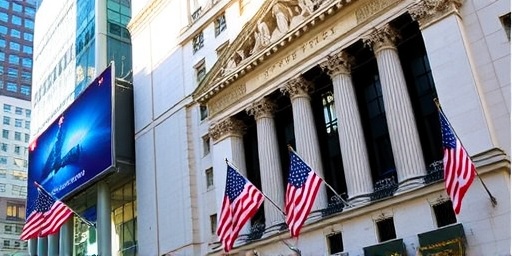In a stunning display of investor enthusiasm, the US Stock market closed at unprecedented levels today, with the Dow Jones Industrial Average and S&P 500 both shattering previous records. The surge, which saw the Dow climb over 400 points to a new peak of 44,500, was propelled by mounting speculation that the Federal Reserve will implement a rate cut in December. This optimism comes as recent economic data points to easing inflation, raising hopes for a softer monetary policy ahead.
The rally marks the fourth consecutive week of gains for major indices, reflecting a broader sentiment of economic resilience despite lingering global uncertainties. Traders on Wall Street were buzzing, with trading volumes spiking 15% above average as institutional investors piled into blue-chip stocks and technology giants. This momentum not only underscores the Stock market‘s sensitivity to Federal Reserve signals but also highlights how cooling inflation figures are reshaping investor strategies.
Dow Jones Shatters Records with Blue-Chip Momentum
The Dow Jones Industrial Average led the charge, surging 1.2% to close at an all-time high of 44,512.13, eclipsing its previous record set just two weeks ago. This milestone was driven by robust performances from cornerstone companies within the index. For instance, financial heavyweights like JPMorgan Chase and Goldman Sachs each posted gains exceeding 2%, buoyed by expectations that a Fed rate cut would stimulate lending and boost corporate profits.
Historical context adds weight to this achievement: the Dow has now risen more than 20% year-to-date, outpacing many global benchmarks. Analysts attribute this to a trifecta of factors—strong corporate earnings, anticipated Fed rate cut benefits, and a labor market that remains tight without overheating. ‘The Dow’s climb isn’t just numbers; it’s a vote of confidence in America’s economic backbone,’ said Michael Thompson, chief market strategist at Vanguard Investments.
Delving deeper, sector-specific data reveals that industrials and consumer discretionary stocks contributed the most to the index’s ascent. Caterpillar Inc., a bellwether for manufacturing, jumped 3.1% after reporting better-than-expected quarterly orders, signaling sustained demand in infrastructure projects. Meanwhile, retail giant Walmart added to the gains, up 1.8%, as shoppers continue to spend amid wage growth outpacing inflation.
However, not all components were unanimous in their upward trajectory. Utilities lagged slightly, down 0.5% on average, as investors rotated out of defensive plays into higher-growth areas. This selective buying pattern illustrates how the Stock market is betting on continued expansion rather than a slowdown, even as Fed rate cut talks dominate headlines.
S&P 500 Mirrors Dow’s Triumph Amid Broad-Based Gains
Parallel to the Dow’s feats, the S&P 500 notched a 1.1% increase, reaching a fresh zenith of 5,650.42 and marking its seventh record close this year. This broad index, which encompasses 500 leading US companies, benefited from widespread participation across sectors, with technology and healthcare leading the pack.
Tech stocks, in particular, reignited after a brief pullback last month. Apple Inc. rose 2.3%, propelled by optimism over holiday sales projections and potential relief from higher interest rates squeezing consumer financing. Similarly, Nvidia Corp. extended its AI-driven rally, gaining 1.9% as demand for semiconductors shows no signs of abating. The S&P 500’s technology sector, which accounts for nearly 30% of the index, has been a key driver, contributing over 40% of the year’s total gains.
Economists note that the S&P 500’s performance is intertwined with inflation trends. The latest Consumer Price Index (CPI) report showed inflation cooling to 2.5% annually, down from 3.2% earlier in the year—a development that fuels Fed rate cut speculation. ‘Lower inflation means the Fed has room to ease without risking a wage-price spiral,’ explained Dr. Elena Ramirez, an economics professor at Columbia University. Her analysis aligns with market data: bond yields dipped to 3.8% today, reflecting bets on imminent policy shifts.
Beyond the headlines, the S&P 500’s volatility index (VIX) fell to 14.2, its lowest in months, indicating reduced fear among investors. This calm contrasts with earlier 2023 turbulence, when geopolitical tensions and banking scares sent ripples through the stock market. Today’s close, with 85% of S&P components in positive territory, paints a picture of synchronized recovery.
Fed Rate Cut Hopes Propel Investor Sentiment Skyward
At the epicenter of today’s stock market euphoria is the growing consensus around a Federal Reserve rate cut. Futures markets now price in an 85% probability of a 25-basis-point reduction at the December meeting, up from 60% a week ago. This shift stems from Chair Jerome Powell’s recent comments hinting at data-dependent decisions, coupled with softer-than-expected jobs data last Friday.
The mechanics are straightforward: lower interest rates reduce borrowing costs for businesses and consumers, potentially igniting spending and investment. In the stock market context, a Fed rate cut often translates to higher valuations, as discounted cash flow models favor future earnings under cheaper capital. ‘This isn’t speculation; it’s arithmetic,’ quipped Sarah Kline, portfolio manager at BlackRock. ‘Every basis point cut could add 1-2% to equity multiples.’
Historical precedents bolster this narrative. During the Fed’s 2019 easing cycle, the S&P 500 surged 28% in a single year following the first cut. Today’s environment, with inflation trending downward and unemployment steady at 4.1%, mirrors those conditions. Yet, caveats remain: persistent supply chain issues in energy could nudge inflation higher, tempering aggressive cuts.
Wall Street’s reaction was visceral. Options trading volume for rate-sensitive financials exploded, while exchange-traded funds (ETFs) tracking the Dow and S&P 500 saw inflows of $2.5 billion—the highest in a month. This liquidity flood underscores how Fed rate cut anticipation is not just lifting indices but reshaping asset allocation strategies across the board.
Cooling Inflation Clears Path for Economic Soft Landing
Underpinning the Fed rate cut buzz is the unmistakable trend of moderating inflation, which has transitioned from a post-pandemic spike to a more manageable pace. September’s Producer Price Index (PPI) rose just 1.8% year-over-year, the slowest in over three years, while core inflation—excluding food and energy—hovered at 2.4%. These figures suggest the Federal Reserve’s aggressive hiking campaign, which pushed rates to 5.25-5.50%, is finally bearing fruit.
For the stock market, this is a boon. Tamed inflation alleviates pressure on corporate margins, allowing companies to pass on fewer cost increases to consumers. Retail sales data released this week showed a 0.4% uptick, defying fears of a spending slowdown. ‘Inflation’s retreat is the stock market’s green light,’ noted Federal Reserve Bank of New York President John Williams in a recent speech, echoing sentiments that have traders optimistic.
Yet, nuances abound. Shelter costs, a stubborn component of CPI, remain elevated at 4.9%, driven by housing shortages. Energy prices, volatile due to Middle East tensions, added 0.2% last month. Economists like those at the Peterson Institute for International Economics warn that while inflation is cooling, a complete victory requires sustained wage moderation—currently at 3.9% growth.
In this landscape, the Dow Jones and S&P 500 are positioning for a ‘soft landing’ scenario, where growth persists without recession. Small-cap stocks, via the Russell 2000, also rose 1.5% today, indicating broad-based confidence that lower rates will particularly aid smaller firms burdened by high debt.
Market Outlook: Sustained Growth on the Horizon Amid Policy Shifts
Looking ahead, the stock market’s trajectory hinges on upcoming economic releases and Fed communications. The November jobs report, due in two weeks, could solidify rate cut expectations if it shows continued softening without mass layoffs. Analysts from Goldman Sachs project the S&P 500 could reach 5,800 by year-end, assuming a December Fed rate cut materializes and inflation dips below 2%.
Global factors add layers: Europe’s central bank is signaling similar easing, potentially boosting US multinationals’ overseas revenues. Conversely, China’s economic slowdown poses risks to commodity-linked stocks in the Dow. Investors are advised to watch Treasury auctions this week, as yield movements could foreshadow Fed intentions.
Longer-term, this rally reinforces the US economy’s adaptability. With corporate balance sheets fortified by $2.1 trillion in cash reserves, companies are primed for expansion under looser policy. ‘The path forward is upward, but vigilance on inflation is key,’ advises Bloomberg economist Tom Orlik. As speculation builds, the stock market stands at a pivotal juncture, where Fed rate cut decisions could cement 2024 as a banner year for the Dow Jones and S&P 500.
Institutional flows suggest sustained interest: pension funds and sovereign wealth entities allocated an additional $10 billion to US equities last quarter. Emerging trends like AI integration and green energy transitions further support growth narratives, positioning the market for multi-year gains if macroeconomic stars align.
Ultimately, today’s records are more than milestones—they signal a resilient stock market ready to navigate policy pivots. Stakeholders from retail investors to CEOs are recalibrating portfolios, betting on inflation’s continued ebb and the Fed’s measured response to propel prosperity.









